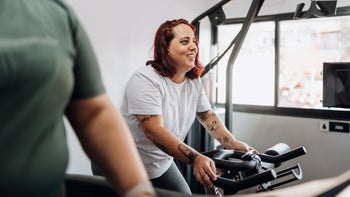
6 IT Band Stretches and Exercises for Pain Relief
Key takeaways:
The iliotibial (IT) band is a thick piece of connective tissue that runs along the outside of the leg, from the hip to the shin. It stabilizes the knee and helps extend and rotate the hip.
Bending and extending the knee repeatedly –– during activities like running or cycling –– can irritate the IT band, causing knee pain or IT band syndrome.
IT band stretches target surrounding muscles to ease pain and tension. Hip-strengthening exercises can help correct muscle imbalances and prevent IT band syndrome from happening again.

Many long-distance runners can tell you about the pain of IT band syndrome. It occurs when repeated bending and extending of the knee irritates the iliotibial band (IT band), a long, thick band of connective tissue on the outside of the thigh. It runs from the hip to the top of the shinbone near the knee. Its main job is to stabilize the knee and leg during movements like walking and running.
IT band syndrome causes pain on the outside of the knee. It may worsen with exercise, making it difficult to stick to your fitness routine. Luckily, certain stretches and exercises can help make IT band pain less likely to happen.
What are the best IT band stretches for pain relief?
Actually, the IT band cannot stretch too much. It needs to remain tight to keep your legs stable during movement. But the tensor fascia latae (TFL) –– a hip muscle attached to the IT band –– can stretch. When the TFL is too tight, it pulls on the IT band. So the best IT band stretches should target the TFL so that it reduces tension on the IT band and relieves pain and friction.
Search and compare options
1. Standing IT band stretch
The standing IT band stretch includes a combination of movements that stretch the muscle fibers in the TFL.
Step 1: Stand tall with your back straight and your feet together. You can stand beside a wall or behind a chair if you need more support.
Step 2: Cross your right leg behind your left, making sure your feet are flat on the floor about shoulder-width apart.
Step 3: Lean toward your left side, feeling the stretch along your right knee, hip, and thigh. To deepen the stretch, reach your arms overhead.
Step 4: Hold this position for 30 seconds.
Step 5: Repeat 3 to 5 times on each side.
2. Cross-legged forward fold
Like the standing IT band stretch, the cross-legged forward fold lengthens the hip muscles. It also targets the hamstrings at the back of the thigh.
Step 1: Stand tall with your back straight and your shoulders down.
Step 2: Cross your right leg in front of your left, keeping your feet flat on the floor about shoulder-width apart.
Step 3: Bend at the hips to fold forward. Place your hands on your shins or the floor.
Step 4: Hold this position for 30 seconds.
Step 5: Repeat 3 to 5 times on each side.
3. Seated IT band stretch
This seated stretch elongates several hip muscles, including those attached to the IT band.
Step 1: Sit upright on the floor with your legs straight out in front of you.
Step 2: Bend your right knee to cross your right leg over your left. Place your right foot flat on the floor outside your left leg.
Step 3: Rotate your body toward your bent leg to look over your shoulder. You can rest your opposite arm on your bent leg to help twist further into the stretch.
Step 4: Hold this position for 30 seconds.
Step 5: Repeat 3 to 5 times on each side.
What are the best strengthening exercises to relieve IT band pain?
Muscle imbalances in the legs can change the alignment of the hip and knee joints with movement. This can increase friction on the IT band near the knee. Corrective exercises that strengthen the hip abductor muscles can help reduce IT band pain. These muscles stabilize the leg and improve hip and knee alignment.
Read more like this
Explore these related articles, suggested for readers like you.
1. Side-lying leg lifts
Side-lying leg lifts work the outer glute muscles that support your hips and knees.
Step 1: Lie on your side with your legs straight and your feet flexed. Your legs should be stacked with your hips, knees, ankles, and feet aligned.
Step 2: Bend your arm and rest your head in your hand. Or, rest your right forearm on the floor.
Step 3: Squeeze your abdominals to engage your core.
Step 4: Raise your top leg, keeping your foot flexed and your hips aligned.
Step 5: Hold for 3 to 5 seconds before slowly lowering your leg to the starting position.
Step 6: Complete 20 reps on each side.
2. Clamshells
Clamshells strengthen the hip muscles that keep your joints aligned to prevent injury. Your legs will mimic a clamshell opening and closing during this exercise.
Step 1: Lie on your side and bend your knees to a 45-degree angle, resting your forearm on the floor. Keep your hips stacked with your feet and ankles touching.
Step 2: Draw your belly button toward your spine to engage your core.
Step 3: Keep your feet together as you lift your top knee toward the ceiling. Try not to shift backward during this movement.
Step 4: Hold at the top for 5 to 10 seconds before lowering your leg to the starting position.
Step 5: Complete 20 reps on each side.
3. Pelvic drops
Pelvic drops or hip hikes challenge your hip muscles to stabilize your pelvis. This exercise can help control the ability of your hip muscles to maintain good alignment of your hips and knees.
Step 1: Stand sideways on an exercise block, with your right foot on the block and your left foot hovering just above the floor.
Step 2: Drop your pelvis slowly to lower your left leg toward the floor. Do not bend your knees.
Step 3: Hike your left hip up to raise your leg to the starting position.
Step 4: Complete 20 reps.
How do you treat IT band syndrome?
IT band syndrome is an overuse condition caused by too much activity without enough rest. Other factors –– including muscle imbalances in the legs and weak hip muscles –– may cause or contribute to IT band syndrome. It commonly occurs in runners and cyclists. But anyone can get IT band syndrome.
The main treatment for IT band syndrome is rest from aggravating movements. Corrective stretching and strengthening exercises that engage the TFL and hip abductor muscles may improve knee alignment, reduce IT band pain, and lower the risk of recurrence. Other treatments, including massage therapy, can also help.
The bottom line
The IT band runs along the outside of the thigh and stabilizes the knee and leg during movement. Overuse –– from bending and extending the knee repeatedly –– can irritate the IT band, causing knee pain or IT band syndrome.
Resting from aggravating movements like running and cycling is critical when you have IT band syndrome. Stretching the TFL muscle that attaches to the IT band can help reduce pain and irritation. Correcting leg muscle imbalances through hip-strengthening exercises can also improve your alignment and prevent IT band pain from coming back.
Why trust our experts?



References
Beals, C., et al. (2013). A review of treatments for iliotibial band syndrome in the athletic population. Journal of Sports Medicine.
Dinescu, L., et al. (2021). Iliotibial band syndrome. PM&R KnowledgeNow.
Hadeed, A., et al. (2022). Iliotibial band friction syndrome. StatPearls.
Hospital for Special Surgery. (n.d.). Iliotibial band (IT band) syndrome.
Khaund, R., et al. (2005). Iliotibial band syndrome: A common source of knee pain. American Family Physician.
Pepper, T. M., et al. (2021). The immediate effects of foam rolling and stretching on iliotibial band stiffness: A randomized controlled trial. International Journal of Sports Physical Therapy.





























